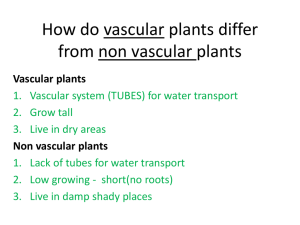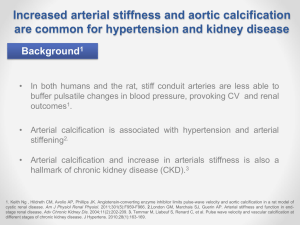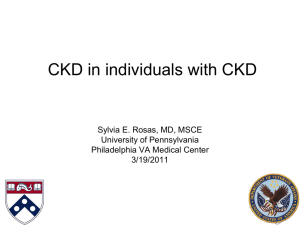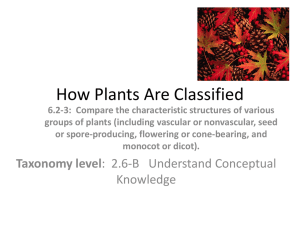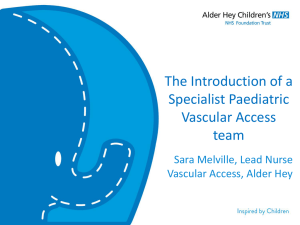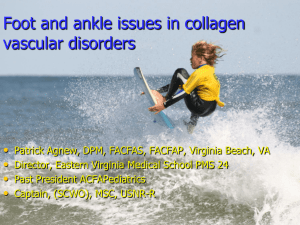Bostrom Slides
advertisement
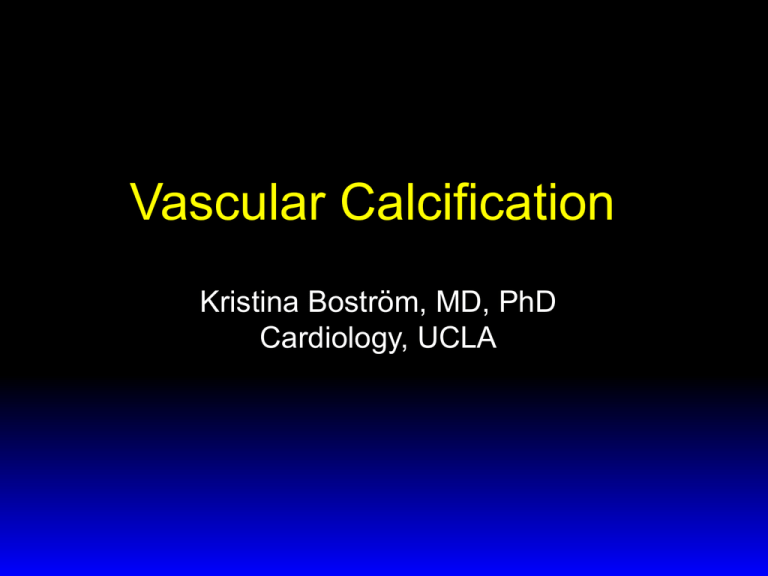
Vascular Calcification Kristina Boström, MD, PhD Cardiology, UCLA Case Presentation 74 y o Caucasian female, with hypertension and critical aortic stenosis. One year prior to presentation, aortic valve replacement had been attempted but was aborted due to severe aortic calcification, so called “porcelain aorta”. Now increasing symptoms of shortness of breath with exertion and chest pain, with recurrent hospital admissions for congestive heart failure. Echocardiogram: LVEF >60% with concentric left ventricular hypertrophy and diastolic dysfunction. Mild mitral regurgitation. Moderate tricuspid regurgitation. Cardiac Catheterization: Normal systolic function. Non-obstructive coronary disease. CT Chest: “Uniform, smooth calcification of the ascending aorta extending from the root to the origin of great vessels, with trivial atherosclerotic calcifications of the descending aorta. The appearance of the ascending aorta is reminiscent of aortic graft.” Extensive aortic valve calcification and moderate mitral valve calcification. Circumferential Calcification in the Ascending Aorta Left Ventricular Apical Conduit to Descending Thoracic Aorta This Case Illustrates …. • Calcification can be characterized by the anatomical location. • There are more than one type of vascular calcification. • We are unable to efficiently treat vascular calcification. • Vascular calcification may cause clinical complications. Vascular Calcification Differs in: Anatomical location Aortic Coronary Peripheral arteries Heart valve Vascular layer Intima Media Adventitia Heart valve Association with disease Atherosclerosis Mönckeberg’s (Media Sclerosis) Diabetes Renal Failure Vascular Calcification Is Associated with Vascular Disease: Intima Atherosclerosis Renal Failure Diabetes Media Mönckeberg’s (Media sclerosis) Renal Failure Diabetes Adventitia Diabetes Heart valves Atherosclerosis Intimal Calcification - Atherosclerosis Sangiorgi et al. JACC 1998 CLINICAL IMPLICATIONS OF INTIMAL CALCIFICATION Coronary Arteries • Correlated with Coronary Artery Disease and atherosclerotic plaque burden. • Associated with Sudden Cardiac Death • Promotes dissection following angioplasty Media Calcified, Atherosclerotic Coronary Artery Intima Calcification Webpath Rupture at Edge of Calcified Lesion In Vitro In Vivo - after angioplasty Mechanical stress analysis of a rigid inclusion in distensible material: a model of atherosclerotic calcification and plaque vulnerability. Hoshino et al. Am J Physiol 2009 Coronary Calcification Detected by Electron Beam CT (EBCT) - “Heart Scans” Coronary Calcification - EBCT A negative EBCT test is associated with a low risk of a cardiovascular event in the next 2 to 5 years. A positive EBCT confirms the presence of a coronary atherosclerotic plaque. The greater the amount of calcium, the greater the likelihood of occlusive CAD, but there is not a 1-to-1 relationship, and findings may not be site specific. The total amount of calcium correlates best with the total amount of atherosclerotic plaque, although the true "plaque burden" is underestimated Atherosclerotic Plaques Medial Calcification VASCULAR MEDIAL CALCIFICATION (Mönckeberg’s media sclerosis, elastocalcinosis) Arteriosclerosis associated with aging, diabetes, and end stage renal disease Webpath Price et al. ATVB 2000 CLINICAL IMPLICATIONS OF VASCULAR MEDIAL CALCIFICATION Aorta • Correlates with increased ischemic episodes in peripheral vascular disease (PVD) Peripheral Arteries • Strong marker for future cardiac events, PVD, and lower extremity amputations in diabetics • Prognostic marker for all-cause and cardiovascular mortality in dialysis patients Causes increased aortic stiffness, pulse pressure, left ventricular hypertrophy and cardiovascular mortality Medial Calcification in Arteries of Dialysis Patients 30-700 fold increase in cardiovascular mortality risk in dialysis patients compared to the general population. Decreased survival in end stage renal disease patient with intimal and medial vascular calcification Moe et al. Kidney Int. 2002 Heart Valve Calcification Normal Aortic Valve Senile Aortic Stenosis Calcified Bioprosthetic Valve CLINICAL IMPLICATIONS OF VALVE CALCIFICATION • Major cause of failure in native valves • Major cause of failure in bioprosthetic valves • Highly prevalent in patients with end stage renal failure Mechanisms of Vascular Calcification Normal Vessels Don’t Mineralize Active Inducers Active Inhibitors Both Inhibitors and Promotors of Calcification in Atherosclerotic Plaques Inhibitors Promotors Dhore et al. ATVB 2001 Major Theories of Vascular Calcification DISTURBED Ca/Pi BALANCE Hyperphosphatemia Hypercalcemia LOSS OF INHIBITION Pyrophosphate MGP OPN Fetuin/alpha2-HS glycoprotein Others Ca x Pi VASCULAR CALCIFICATION CIRCULATING NUCLEATIONAL COMPLEXES INDUCING FACTORS Pi Lipids Inflammatory cytokines Others INDUCTION OF BONE FORMATION Vascular bone and cartilage-like cells Matrix Vesicles Apoptotic bodies Bisphosphonates OPG Bone Remodeling CELL DEATH Adapted from Speer & Giachelli, Cardiovasc Path 2004 Major Theories of Vascular Calcification DISTURBED Ca/Pi BALANCE Hyperphosphatemia Hypercalcemia LOSS OF INHIBITION Pyrophosphate MGP OPN Fetuin/alpha2-HS glycoprotein Others Ca x Pi VASCULAR CALCIFICATION CIRCULATING NUCLEATIONAL COMPLEXES INDUCING FACTORS Pi Lipids Inflammatory cytokines Others INDUCTION OF BONE FORMATION Vascular bone and cartilage-like cells Matrix Vesicles Apoptotic bodies Bisphosphonates OPG Bone Remodeling CELL DEATH Adapted from Speer & Giachelli, Cardiovasc Path 2004 GENERALIZED INFANTILE ARTERIAL CALCIFICATION • Rare human genetic disorder; early lethal • Vascular medial calcification leading to a stenosing, fibroproliferative arterial process • Characterized by deficiency in extracellular pyrophosphate (PPi), due to a deficiency in PPi-generating nucleoside triphosphate pyrophosphohydrolase plasma membrane 1 enzyme (PC-1, ENPP1). Long-axis image of aorta and aortic arch Levine et al. Circulation 2001 Matrix Gla Protein (MGP) Inhibitor of Bone Morphogenetic Proteins (BMP) (Zebboudj 2002, Yao 2006) Dependent on Vitamin K for correct gamma-carboxylation of glutamates (Gla-modifications) and anti-calcific activity (Murshed 2004) Dependent on specific proline and Gla-residues for BMP binding (Yao 2008) MGP loss of function mutations in humans cause Keutel syndrome (Keutel 1971, Munroe 1999) Vascular Calcification in MGP Null Mice MGP null Aortic media Wild type Aortic media Luo et al. Science 1997 BONE MORPHOGENETIC PROTEINS (BMP) • Potent inducers of bone formation • Inflammatory mediators induced in vascular endothelium by abnormal oscillatory flow (Sorescu et al. 2004) • Promotes hypertension and atherogenesis in mice (Miriyala et al. 2006, Jo et al. - in prep.) • MGP reduces formation of atherosclerotic plaques and lesions calcification (Yao et al. - in revision) Warfarin / Coumadin Use: • Inhibits MGP gamma-carboxylation, induces vascular calcification in growing rats (Price 1998, Essalihi 2003, Schurgers 2007) • Correlated with increased coronary and valve calcification (Schurgers 2004, Koos 2005) • Associated with calcific uremic arteriolopathy in dialysis patients (Coates 1998, Piccoli 2002) Fetuin, 2 Hermann-Schmid Glycoprotein (AHSG) • Made in the liver • Inhibitor of spontaneous hydroxyapatite (HA) formation from supersaturated calcium- and phosphate containing solutions • Fetuin null mice have decreased serum HA inhibitory activity and increased soft tissue calcification (Jahnen-Dechent 1997, Schafer 2003) Normal mouse after phosphate challenge Fetuin-deficient mouse after phosphate challenge Westenfeld et al. Trends Cardiovasc Med 2007 OSTEOPONTIN • Acidic phosphoprotein found in bone and teeth • Inhibitor of apatite crystal growth • Promotes osteoclast function Osteopontin Deficiency Worsens Calcification in MGP Null Mice Speer MY et al. 2002 Major Theories of Vascular Calcification DISTURBED Ca/Pi BALANCE Hyperphosphatemia Hypercalcemia LOSS OF INHIBITION MGP OPN Fetuin/alpha2-HS glycoprotein Pyrophosphate Others Ca x Pi VASCULAR CALCIFICATION CIRCULATING NUCLEATIONAL COMPLEXES INDUCING FACTORS Pi Lipids Inflammatory cytokines Others INDUCTION OF BONE FORMATION Vascular bone and cartilage-like cells Matrix Vesicles Apoptotic bodies Bisphosphonates OPG Bone Remodeling CELL DEATH Adapted from Speer & Giachelli, Cardiovasc Path 2004 Ectopic Calcification in Atherosclerotic Plaqes Chondrocytes in Mouse Atherosclerotic Lesions Rattazzi et al. ATVB 2005 Mineral Precipitation Ca2+ Cell Differentiation osteoblast-like cell PO42- matrix vesicles CaPO4 mineral precipitation “Active” inhibitor Ca2+ PO42- CaPO4 mineral precipitation osteoid (matrix) hydroxyapatite Potential Origins of Osteoblast-like Cells in the Artery Wall • Pericytes • Mesenchymal stem cells • Multipotent cells from the adventitia • Resident cells in the media or intima • Trans-differentiated SMC (Synthetic vs contractile phenotype) Calcifying Vascular Cells (CVC) UNDIFFERENTIATED CONDENSATION CALCIFIED NODULES Bone Related Factors in Calcified Artery Wall BMP-2 and -4 Cbfa1 Osterix Collagen I Alkaline Phosphatase Osteocalcin Hydroxyapatite Osteopontin Matrix GLA protein (MGP) Osteoprotegerin … and others ….. Both Inhibitors and Promotors of Calcification in Plaques Dhore et al. ATVB 2001 Major Theories of Vascular Calcification DISTURBED Ca/Pi BALANCE Hyperphosphatemia Hypercalcemia LOSS OF INHIBITION MGP OPN Fetuin/alpha2-HS glycoprotein Pyrophosphate Others Ca x Pi VASCULAR CALCIFICATION CIRCULATING NUCLEATIONAL COMPLEXES INDUCING FACTORS Pi Lipids Inflammatory cytokines Others INDUCTION OF BONE FORMATION Vascular bone and cartilage-like cells Matrix Vesicles Apoptotic bodies Bisphosphonates OPG Bone Remodeling CELL DEATH Adapted from Speer & Giachelli, Cardiovasc Path 2004 Normal Vessels Don’t Mineralize (Despite serum Ca x P at or near solubility product) Active Inducers Active Inhibitors Intima Atherosclerosis Renal Failure Diabetes Media Mönckeberg’s (Media sclerosis) Renal Failure Diabetes Adventitia Diabetes Heart valves Atherosclerosis Calcium x Phosphate Product Already above precipitation point at certain places Renal failure may increase Ca x P product further Hyperphosphatemia: Major independent risk factor for vascular calcification and cardiovascular mortality in dialysis patients (Block 1998, 2004, Goodman 2000, Shigematsu 2003, Young 2005) Phosphate-Induced Changes in SMC Differentiation Pi/Ca Contractile SMC SM-MHC SM22alpha SM-alpha actin Desmin Osteochondrogenic cell Cbfa1 OPN Osteocalcin Alk Phos Type III sodium-dependent phosphate co-transporters (Pit-1, Pit-2) Blockage of these transporters leads to phosphate induced SMC mineralization Pit-1 can be induced by BMP-2 Calcified Vascular Smooth Muscle Cells Wada et al. Circ Res 1999 Major Theories of Vascular Calcification DISTURBED Ca/Pi BALANCE Hyperphosphatemia Hypercalcemia LOSS OF INHIBITION MGP OPN Fetuin/alpha2-HS glycoprotein Pyrophosphate Others Ca x Pi VASCULAR CALCIFICATION CIRCULATING NUCLEATIONAL COMPLEXES INDUCTION OF BONE FORMATION Vascular bone and cartilage-like cells Matrix Vesicles Apoptotic bodies Bisphosphonates OPG Bone Remodeling INDUCING FACTORS Pi Lipids Inflammatory cytokines Others CELL DEATH Degenerative Joint Diseases Connection between are “Crystal diseases” Vascular Calcification and Bone where synovial fibroblasts have an inflammatory response to the crystals. Aortic Calcification and Osteoporosis Frequently Coexist Similarities to Bone: Bone Proteins Osteoblast-like Cells Osteoclast-like Cells “The paradox of arterial calcification in osteoporotic patients” Parhami et al. ATVB 1997 Oxidized lipids or other agents may be mediating the effect. Mody et al. J Nucl Card 2003 Resorptive osteoclast-like cells are found in calcified atherosclerotic lesions. (Tintut et al. 2002) Maybe derived from blood monocytes Osteoclast-like cell with multiple nuclei Osteoprotegerin (OPG) OPG is a secreted protein that inhibits osteoclast formation OPG deficient mice have osteoporosis and arterial (medial) calcification OPG Null Mouse Bucay et al. Genes & Development 1998 Bone Resorption in the Skeleton Often Coexists with Bone Formation in the Vasculature Panizo et al., Circ Res 2009 Alexander, Circ Res 2009 VASCULAR CALCIFICATION AND INFLAMMATION The Size of Vascular Calcification May Matter! Large Chunks Dhore et al. ATVB 2001 Small BCP Crystals Engelse et al.2001 BCP = Basic calcium phosphate Degenerative Joint Diseases are “Crystal diseases” where synovial fibroblasts have an inflammatory response to the crystals. Nadra et al. Circ Res 2005 The ingestion of BCP crystals by human monocyte-derived macrophages generates a pro-inflammatory response. BCP Crystals Induces Pro-Inflammatory Factors in Macrophages TNF-alpha TNF-alpha Increases Calcification in Calcifying Vascular Cells (CVC) Nadra et al. Circ Res 2005 Tintut et al. Circ 2000 Large calcified areas may be less pro-inflammatory. How dangerous is the calcification we find on EBCT? Mouse models for vascular calcification Genes Associated with Ectopic Calcification in Mice MUTATION PHENOTYPE Matrix Gla Protein Arterial, valve and cartilage calcification Fetuin Decreased serum HA inhibitory activity Osteopontin Increased calcification of implanted bioprosthetic valves Fibrillin Vascular calcification, aortic stenosis Osteoprotegerin Osteoporosis, vascular calcification FGF23 Hyperphosphatemia, vascular calcification PC-1/Enpp1/NPP1 (nucleotide pyrophosphatase) Vascular and articular cartilage calcification Ank (pyrophosphate transporter) Articular cartilage calcification, soft tissue calcification ß-glucosidase (klotho) Vascular calcification, rapid aging Carbonic Anhydrase II Calcification of small arteries Smad6 Valve calcification Desmin Neonatal cardiomyopahty with calcificationAriall Mouse Models Illustrate the Diversity of Vascular Calcification MGP knockout Fibrillin-1 deficient Fat-fed ApoE (or LDLR) knockout mice Carbonic anhydrase II deficient OPG knockout Warfarin treated rat VitD/Ca Smad6 knockout Vascular calcification is heterogeneous and is triggered through multiple mechanisms

